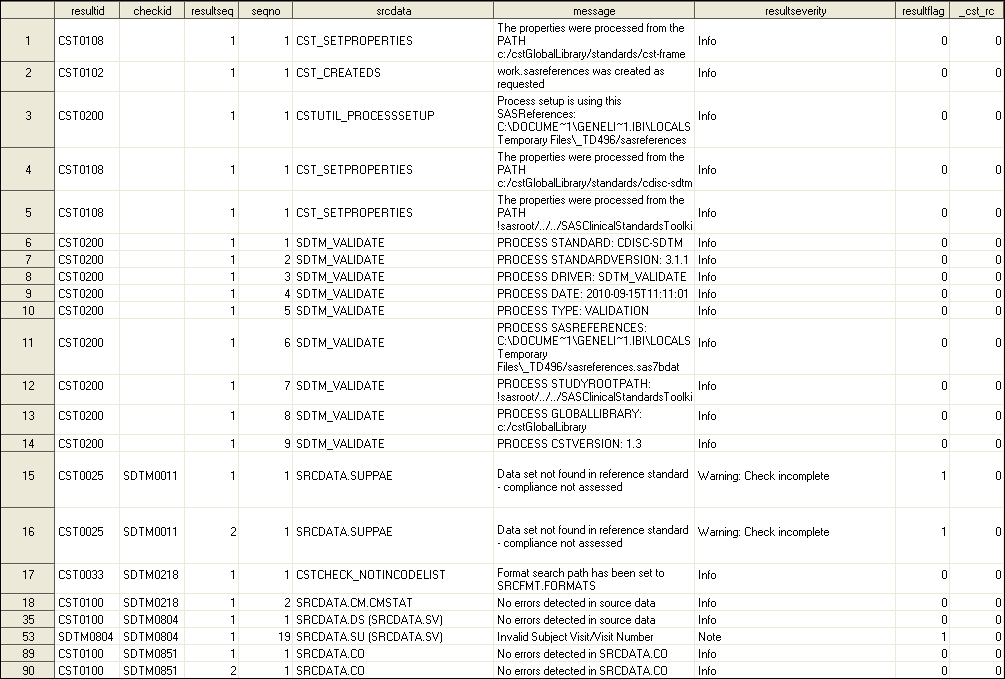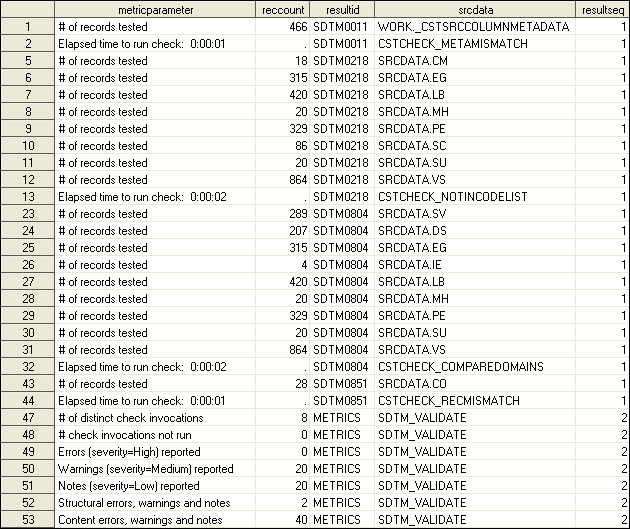Running a Validation Process
Sample CDISC SDTM 3.1.1 Driver Program: validate_data.sas
Overview
Each SAS Clinical Standards
Toolkit process uses a SAS driver module to set up the program execution
flow. The following steps show the execution flow in a typical SAS
driver module to perform the SAS Clinical Standards Toolkit validation.
For example, in a SAS 9.3 deployment, the CDISC SDTM 3.1.2 validation
driver module is in:
!sasroot /../../SASClinicalStandardsToolkitSDTM312/1.4/sample/cdisc-sdtm-3.1.2/sascstdemodata/programs/validate_data.sasStep 1: Define the locations of the study data and the metadata.
/* There are several ways to define the study data and metadata
locations. These include (but are not limited to):
- Pre-allocation of libraries through some user-defined set-up mechanism
- Definition within a user-defined driver program such as this one
- Full explicit definition within a work sasreferences control data set
- Use of a global macro variable referenced within each sasreferences file
This driver program illustrates use of the last mechanism, setting the
global macro variables studyRootPath and studyOutputPath, which are referenced
within the sample study sasreferences data set path column.
Note this example is dependent on the SAS version and installation folder structure. */
data _null_;
select("&sysver");
when("9.1")
do;
call symput('studyRootPath','!sasroot/../SASClinicalStandardsToolkitSDTM312
/1.4/sample/cdisc-sdtm-3.1.2/sascstdemodata');
call symput('studyOutputPath','!sasroot/../SASClinicalStandardsToolkitSDTM312
/1.4/sample/cdisc-sdtm-3.1.2/sascstdemodata');
end;
otherwise do;
call symput('studyRootPath','!sasroot/../../SASClinicalStandardsToolkitSDTM312
/1.4/sample/cdisc-sdtm-3.1.2/sascstdemodata');
call symput('studyOutputPath','!sasroot/../../SASClinicalStandardsToolkitSDTM312
/1.4/sample/cdisc-sdtm-3.1.2/sascstdemodata');
end;
end;
run;The &studyRootPath
and &studyOutputPath variables facilitate code standardization
and portability. They are not required.
The workPath value provides
the path for the Work directory. This directory is referenced within
the sample study SASReferences data set path column. It is not required.
* Note the number of calls should match the unique studyOutputPath subdirectories in sasreferences *; %****let studyOutputPath=users/myname/mystudy; *<--- example user override *; %****csutil_createsubdir(_cstSubDir=results); *<--- example user override *;
The SAS Clinical Standards
Toolkit processes normally create one or more output files. These
files might reside in the Work directory or point to some external
location. The &studyRootPath variable points to read-only locations
in the !sasroot folder hierarchy.
The &studyOutputPath variable points to writable locations for
process output, often in the !sasroot folder hierarchy. UNIX users (or any users) might find it necessary
to reset &studyOutputPath to some write-enabled location since
the !sasroot directories
are typically Write protected. For these users, calls to the %cstutil_createsubdir
macro create any workpath subdirectories that are expected by SASReferences
records and set &studyOutputPath to workpath.
Step 2: Set the SAS Clinical Standards Toolkit framework properties and the global macro variables.
* Set properties provided as part of the CST-FRAMEWORK standard. ; %cst_setstandardproperties( _cstStandard=CST-FRAMEWORK,_cstSubType=initialize); %cst_createds(_cstStandard=CST-FRAMEWORK, _cstType=control,_cstSubType=reference, _cstOutputDS=work.sasreferences);
Each registered standard
should have its own initialize.properties. For each standard that
is included in a specific process, the %cst_setstandardproperties
macro can be called at this point. Alternatively, type=properties
records can be added to the SASReferences data set, and properties
are processed when the %cstutil_allocatesasreferences macro is called.
This latter approach is followed in the SDTM validate_data.sas driver
module.
Step 3: Set the version of the controlled terminology.
The following macro
selects the version of the controlled terminology required by the
validation process. In the following example, the standard is CDISC-Terminology.
The %cst_getstandardsubtypes macro builds a work data set named work._cstStdSubTypes,
which contains all records for the CDISC-Terminology standard. A DATA_NULL_step
subsets the values to a specific &_cstStandard (in this case,
CDISC-SDTM). The value of the variable isstandarddefault is equal
to
Y. Values from this single observation
are used to create the macro values for &_cstCTRoot and &_cstCTDescription.
You can override the version of the controlled terminology by setting
&_cstCTRoot to any directory. (This is shown in the commented
line.)
* Set Controlled Terminology version for this process *;
%cst_getstandardsubtypes(_cstStandard=CDISC-TERMINOLOGY,_cstOutputDS=work._cstStdSubTypes);
data _null_;
set work._cstStdSubTypes (where=(standardversion="&_cstStandard" and isstandarddefault='Y'));
call symputx('_cstCTRoot',cats(lowcase(standardversion),'/',
lowcase(standardsubtypeversion)));
call symputx('_cstCTDescription',description);
run;
%**let _cstCTRoot=cdisc-sdtm/201003; * <----- User can override
CT version of interest *; Step 4: Create an empty work.sasreferences data set to be populated in the validation process, and build the work.sasreferences data set.
%cst_createds(_cstStandard=CST-FRAMEWORK, _cstType=control, _cstSubType=reference, _cstOutputDS=work.sasreferences);
The validate_data.sas
module initializes the SASReferences data set that is required for
SDTM validation. The SASReferences data set defines the location and
name of the Validation Control data set. The Validation Control data
set contains the set of checks to be included in the validation process.
The sample validate_data.sas driver program, sets the path of the
Validation Control data set to
&studyRootPath/control and name to validation_control.sas7bdat. In SAS 9.3, this translates to !sasroot/../../ SASClinicalStandardsToolkitSDTM312/1.4/sample/cdisc-sdtm-3.1.2/sascstdemodata/control/validation_control.sas7bdatStep 5: Call the %cstutil_processsetup macro.
The %cstutil_processsetup
macro completes process setup. It ensures that all SAS librefs and
filerefs are allocated; all system options, macro autocall paths,
and format search paths are set; and that all global macro variables
that are required by the process have been appropriately initialized.
The %cstutil_processsetup
macro uses these parameters.
This parameter determines
what initial source setup should be based on. Valid values are SASREFERENCES
(default) or RESULTS. If RESULTS is specified, then no other parameters
are required, and setup responsibility is passed to the cstutil_reportsetup
macro. The Results data set name must be passed to cstutil_reportsetup
as libref.memname.
The %cstutil_processsetup
macro call:
%cstutil_processsetup();in the validate_data.sas driver reflects the acceptance of the macro parameter defaults listed above.
The %cstutil_processsetup
macro parameter values tell the process where to find the SASReferences
data set.
*********************************************************************; * Set global macro variables for the location of the sasreferences *; * file (overrides default properties initialized above *; *********************************************************************; %let _cstSASRefsName=&_cstSASReferencesName; %let _cstSASRefsLoc=&_cstSASReferencesLocation;
The final setup step
for the %cstutil_processsetup macro is a call to the %cstutil_allocatesasreferences
utility macro. The SASReferences data set is now interpreted by the
SAS Clinical Standards Toolkit. These actions complete the process:
-
The %cst_insertstandardsasrefs macro is called to insert paths into any records that are missing path information. The information is captured from the StandardSASReferences data set for each standard. For more information about how this works, see Inserting Information from Registered Standards into a SASReferences File.
At this point, all libraries
should be allocated, all paths and global macros should be set, and
the global status macro variable _cst_rc should be set to 0. The process
is ready to proceed.
CAUTION:
The SASReferences
data set is key to the process, and any errors will cause the process
to fail.
This is a common process
failure point because of the importance of the SASReferences data
set. For tips on
debugging problems with the SASReferences data set, see Special Topic: Debugging a Validation Process.
Step 6: Run validation tasks.
For tips on
debugging if unexpected errors occur, see Special Topic: Debugging a Validation Process.
Step 7: Clean up the session.
Parameter Details
This table summarizes
what the SAS Clinical Standards Toolkit attempts to do when each of
the %cstutil_cleanupcstsession macro parameters is enabled.
Parameter Details for the %cstutil_cleanupcstsession Macro
Validation Results and Metrics
For SAS Clinical Standards
Toolkit validation processes, the primary products of each validation
process are the Results data set and the Metrics data set. These data
sets itemize and summarize the findings of the validation process.
Example of a Validation Results Data Set (#1) summarizes a sample validation
process. Here are a few facts about the sample
validation process:
-
It included SASReferences records to persist the results as results.validation_results and results.validation_metrics.Comments about the Validation Results Data Sets in Displays 6.9 and 6.10Comments about the Validation Metrics Data SetA summary metric of unique check invocations. Example of a Validation Metrics Data Set does not itemize all eight checks.
Note: In Example of a Validation Results Data Set (#1)and Example of a Validation Results Data Set (#2), some records in the validation Results data set have been
deleted for brevity. This creates
an inconsistency with the metrics listed in Example of a Validation Metrics Data Set.
Here are some general
observations:
-
The seqno field is intended to be a record (message) counter in each specific check invocation. Generally, this value starts with 1 on the first record, and increments by 1 until the last record for each checkid and resultseq combination. One exception is with the Validation Control column reportAll=N. This signals the code to not write a record to the Results data set for each record in error. However, seqno continues to increment in this case, resulting in a gap in seqno values, with the last seqno approximating the total number of records in error.
A set of sample validation
reports is available to summarize the SAS Clinical Standards Toolkit
validation process results and metrics. For more
information, see Reporting.
Sample CDISC CRT-DDS 1.0 Driver Program: validate_crtdds_data.sas
The SAS Clinical Standards
Toolkit validation of the SAS representation of the CDISC CRT-DDS
standard follows the same pattern used for CDISC SDTM validation.
A sample driver module, validate_crtdds_data.sas, is provided to perform
process setup steps and to call the crtdds_validate.sas macro. For a more
complete description of the validation of the SAS representation of
the CDISC CRT-DDS standard, see XML-Based Standards. In this chapter, the use of the validate_crtdds_data
driver module is described.


